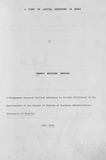| dc.description.abstract | The capital structure of a firm is influenced by certain factors. However what these factors are is still not very clear. Different
researchers e.g. Kamere(-1987) and Baliga, (1987) Ferri and Jones (1979)
etc. obtained differing conclusions on what the important determinants
of cap~tal structure are •
•This study aims at first of all determining what the capital
structures of Kenyan public firms are. Secondly, the study tries to find out on the basis of other researchers findings, which factors significantly influence capital structure in the Kenyan environment. The factors which
were tested are The Firms Age, Industrial Class, Growth, Size, Interest Charges, Variability in Cashflows, Profitability, Asset Structure and Ownership.
The study found that though Industrial Class is not statistically significant, the capital structures of firms on the sectoral basis are quite different. The Industrial and Allied Sector has the highest
debt-equity ratio of 0"301 f olLowed by the Agricultural Sector with
0.108. Third comes the Financial and Investment Sector with 0.058
and last comes the Commercial and Allied Sector with a ratio of 0.009. A test was done to compare the pre-and-post-liberalisation capital structures and the results indicated that the two periods are
significantly correlated implying that liberalisation has so far not created
much impact on capital structures of Public Kenyan firms.
Regarding ownership, government-controlled enterprise~ had the highest debt-equity ratio follwed by the locally controlled enterprises and finally the overseas controlled enterprises.
The results obtained from the other tests indicate that in the combined run of the sectors, four out of eight factors tested, proved to be significantly correlated with capital structure and these were,
Profitability, with a coefficient of 0.65017 Growth in Turnover with a
coefficient of 0.48498, Growth in Asset Value with a coefficient of
0.55666 and Asset Structure with a coefficient of 0.40354. The least correlated factor was Interest Charges with a coefficient of 0.06939.
In the Agricultural Sector, the Changes in Movement of Working Capital was the only factor that turned out significantly correlated with Capital Structure. The factors Asset Structure and Grwoth in Turnover both had positive insignificant correlation coefficients while the factors Profitability, Interest Charges and Turnover had
negative insignificant correlation coefficients with capital
structure.
In the Industrial and Allied Sector, no factor tested had a significant correlation relationship with Capital Structure though the highest
correlated factor was Growth in Turnover. The least correlated was the
Changes in Movement of Working Capital. The factors Profitability and
Interest Charges had negative correlation coefficients at -0.354 and
-0.381 respectively.
For the Commercial and Allied Sector, Profitability and Asset Structure proved to be significantly correlated with Capital Structure having positive values of 0.846 and 0.743 respectively. The least correlated factor was Interest Charges which was negatively correlated
with a coefficient of -0.009. The other factors were positively correlated.
In the Financial and Investment Sector, no factor tested, showed any significant correlation with Capital Structure. However out of
all of them, Profitability was the highest correlated with a coefficient
•
of 0.761. The least correlated was Asset Structure which had a value
of 0.09. The factors Changes in Movement of Working Capital and Turnover both had negative correlation coefficients suggesting opposite movements with capital structure.
All in all, the results from the sectoral tests do indicate that there are disparities in the factors that influence Capital s/tructure. Possible explanations for this are presented in this text however suffice to state that most differences arise from the very natures of sectors themselves | en |

